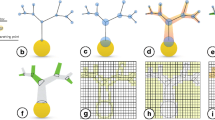Abstract
Detailed cell and network morphologies are becoming increasingly important in Computational Neuroscience. Great efforts have been undertaken to systematically record and store the anatomical data of cells. This effort is visible in databases, such as NeuroMorpho.org. In order to make use of these fast growing data within computational models of networks, it is vital to include detailed data of morphologies when generating those cell and network geometries. For this purpose we developed the Neuron Network Generator NeuGen 2.0, that is designed to include known and published anatomical data of cells and to automatically generate large networks of neurons. It offers export functionality to classic simulators, such as the NEURON Simulator by Hines and Carnevale (2003). NeuGen 2.0 is designed in a modular way, so any new and available data can be included into NeuGen 2.0. Also, new brain areas and cell types can be defined with the possibility of constructing user-defined cell types and networks. Therefore, NeuGen 2.0 is a software package that grows with each new piece of anatomical data, which subsequently will continue to increase the morphological detail of automatically generated networks. In this paper we introduce NeuGen 2.0 and apply its functionalities to the CA1 hippocampus. Runtime and memory benchmarks show that NeuGen 2.0 is applicable to generating very large networks, with high morphological detail.









Similar content being viewed by others
References
Andersen, P., Morris, R., Amaral, D., Bliss, T., O’Keefe, J. (2007). The hippocampus book (1st ed.). London: Oxford University Press.
Ascoli, G.A. (2006). Mobilizing the base of neuroscience data: the case of neuronal morphologies. Nature Reviews Neuroscience, 7, 318–324.
Ascoli, G.A., & Atkeson, J.C. (2005). Incorporating anatomically realistic cellular-level connectivity in neural network models of the rat hippocampus. Biosystems, 79(1–3), 173–181.
Ascoli, G.A., & Krichmar, J.L. (2000). L-Neuron: a modeling tool for the efficient generation and parsimonious description of dendritic morphology. Neurocomputing, 32–33, 1003–1011.
Cannon, R.C., Turner, D.A., Pyapali, G.K., Wheal, H.V. (1998). An on-line archive of reconstructed hippocampal neurons. The Journal of Neuroscience Methods, 84(1–2), 49–54.
CoreTeam, R. (2008). R: A language and environment for statistical computing. http://www.R-project.org. ISBN 3-900051-07-0.
Freund, T.F., & Buzsaki, G. (1996). The interneurons of the Hippocampus. Hippocampus, 6, 347–470.
Gleeson, P., Crook, S., Cannon, R.C., Hines, M.L., Billings, G.O. (2010). NeuroML: a language for describing data driven models of neurons and networks with a high degree of biological detail. PLoS Computational Biology, 6(6), e1000815. doi:10.1371/journal.pcbi.1000815.
Gleeson, P., Stauber, V., Silver, R.A. (2007). NeuroConstruct: a tool for modeling networks of neurons in 3D space. Neuron Neurotechnique, 54, 219–235.
Gulyas, A.I., Megias, M., Emri, Z., Freund, T.F. (1999). Total number and ratio of excitatory and inhibitory synapses converging onto single interneurons of different types in the CA1 area of the rat hippocampus. The Journal of Neuroscience, 19(22), 10082–10097.
Hines, M.L., & Carnevale, N.T. (2003). The NEURON simulation environment. In M.A. Arbib (Ed.), The handbook of brain theory and neural networks (Vol. 2, pp. 769–773). Cambridge: MIT Press.
Ishizuka, N., Cowan, W.M., Amaral, D.G. (1995). A quantitative analysis of the dendritic organization of pyramidal cells in the rat hippocampus. Journal of Comparative Neurology, 362, 17–45.
Java3D (2012). http://java3d.java.net/. Accessed 25 September 2012.
Koene, R.A., Tijms, B., van Hees, P., Postma, F., de Ridder, A., Ramakers, G.J., van Pelt, J., van Ooyen, A. (2009). NETMORPH: a framework for the stochastic generation of large scale neuronal networks with realistic neuron morphologies. Neuroinformatics, 7(3), 195–210.
ModelDB (2012). http://senselab.med.yale.edu/modeldb/. Accessed 25 September 2012.
NeuroMorpho (2012). http://neuromorpho.org/. Accessed 25 September 2012.
Siekmeier, P.J. (2009). Evidence of multistability in a computer simulation of hippocampus subfield CA1. Behavioral Brain Research, 200(1), 220–231.
Vogel, A., Reiter, S., Rupp, M., Nägel, A., Wittum, G. (2012). uG 4—a novel flexible software system for the simulation of PDE-based models on high performance computers. Computation and Visualization in Science, to appear.
Zubler, F., & Douglas, R. (2009). A framework for modeling the growth and development of neurons and networks. Frontiers in Computational Neuroscience, 3(25). doi:10.3389/neuro.10.025.2009.
Author information
Authors and Affiliations
Corresponding author
Additional information
The project was funded by the Baden-Württemberg Stiftung.
Rights and permissions
About this article
Cite this article
Wolf, S., Grein, S. & Queisser, G. Employing NeuGen 2.0 to Automatically Generate Realistic Morphologies of Hippocampal Neurons and Neural Networks in 3D. Neuroinform 11, 137–148 (2013). https://doi.org/10.1007/s12021-012-9170-1
Published:
Issue Date:
DOI: https://doi.org/10.1007/s12021-012-9170-1



